by Andrew | Jul 28, 2015 | In the news, Inflation, inflation measure
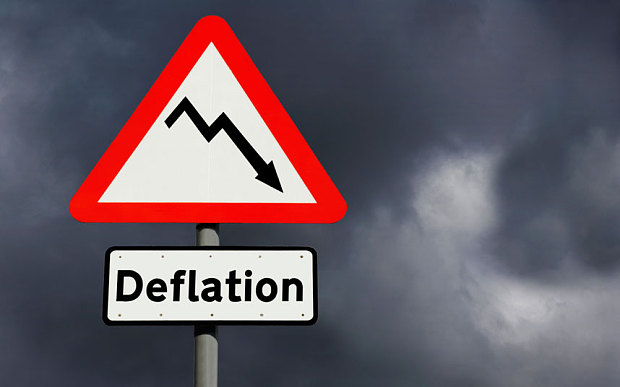
Commodity prices have been plunging in recent weeks, with the Bloomberg commodities index falling to an 11-year low, a drop of nearly 42 per cent since its peak in 2008. Plunging prices for natural resources are stoking real concerns that the deflationary conditions which plagued the US economy during the first quarter of 2015 could return with a vengeance in the months ahead. Commodity markets have been under pressure for most of the year on expectations of an imminent rate hike by the Federal Reserve, but the rout has been accelerating viciously in recent weeks due to ongoing concerns with a broad based economic slowdown in China. While the Chinese stock market has been grabbing headlines for the past few months, the real danger lies with problems bubbling under the surface of the country’s “real” economy. Recent Purchasing Manager Index data from China has been abysmal, with the latest figures showing PMI at a 15 month low. Growing signs of stress amongst Chinese purchasing managers does not bode well for the world at large. Slowing demand worldwide combined with an oversupply of inventory due to excessive production in China is likely to trigger another wave of deflation in the coming months – which should, all else being equal, curtail any potential rate hike by the Fed.
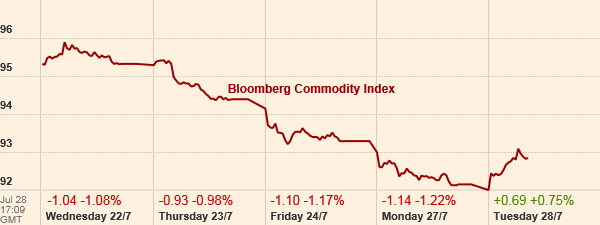
Central Banks are EASING Globally
Compounding the situation at the Fed is a scramble amongst central banks across the world to increase their monetary stimulus packages to help contain the economic carnage which has been unleashed in their respective nations due to interest rate differential expectations in some cases, and plunging commodity based revenues on the other. Canada was the first country to concede “all is not well”, with the central bank cutting interest rates and lowering its GDP forecast for the rest of the year due to falling oil sector investment. Both Australia and New Zealand have followed suit, with both countries looking increasingly vulnerable to any potential slowdown in China. The currencies of both countries have fallen sharply in value in recent months – with no sign of relief in the near future.
In the case of China, it is estimated that the country experienced $224 billion of capital outflows in the second quarter, an eye watering number which has forced the PBOC to tap into its foreign reserves in order to defend the Yuan. If China is having to resort to such measures to defend its currency, what chance do more vulnerable emerging markets have? Nations like Brazil, South Africa, Indonesia, are all seeing severe currency crises which in some cases could spark into full blown regional banking crises should the current financial conditions persist.
So where does this leave the Fed? In no uncertain terms, an increase in rates by the Fed any time soon will push the vast majority of the world over the proverbial edge, and it wouldn’t take long for the ramifications of such economic pain to begin reverberating within the US economy itself.
The Fed’s hands are tied… again

The unfolding commodity carnage will start to impact wall street GDP forecasts and earnings estimates in the days and weeks ahead as analysts begin to digest the implications of slowing demand worldwide. Downward revision to GDP forecasts will be the death knell for rising rates, and will eclipse any positive data which may be appearing on the employment front. Once again the Fed will find itself trapped between seemingly “improving” signs domestically, and full scale carnage internationally. The long run implications of this dilemma are worrying. Should deflationary pressures increase dramatically in the coming months, there will be an expectation on the Fed to embark upon the same easing measures which have led to the current situation in the first place. China undergoing a period of market turmoil as a direct result of the zero interest rate policies being implemented by central banks all over the world. The inflation which failed to show up in developed economies, was unleashed with a vengeance in Chinese financial assets. The market may very well expect and demand another round of QE, and they may very well even get it, but the question has to be asked, will it matter any more? And if it doesn’t matter, what comes next? The answer to that looks increasingly like a breakdown in faith in central banks, as they fight wearily on against increasingly frequent financial storms.
by Andrew | Jul 17, 2015 | BLS, CPI, Definitions, In the news, Inflation, Monthly CPI Updates
U.S. consumer prices increased for the fifth consecutive month in June, led higher by a rebounding price of gasoline, although there was nothing in the latest release which should pose any immediate alarm for markets or consumers at large. The latest report from the BLS reported an overall increase in headline inflation of 0.3% month on month – an increase that was inline with nearly all economists polled prior to the announcement. Looking at the headline number on an annualized basis, inflation rose 0.1 percent In the 12 months through June, following an unchanged reading for the month of May.
Gasoline prices rose 3.4% month on month, following a 10.4 percent surge in May. Given the recent volatility in crude oil prices and inventory data in July, there could be scope for the influence of rising gas prices to subside in coming months. Oil is currently trading within the $50-60 / bbl range, well below the levels seen in May and June.
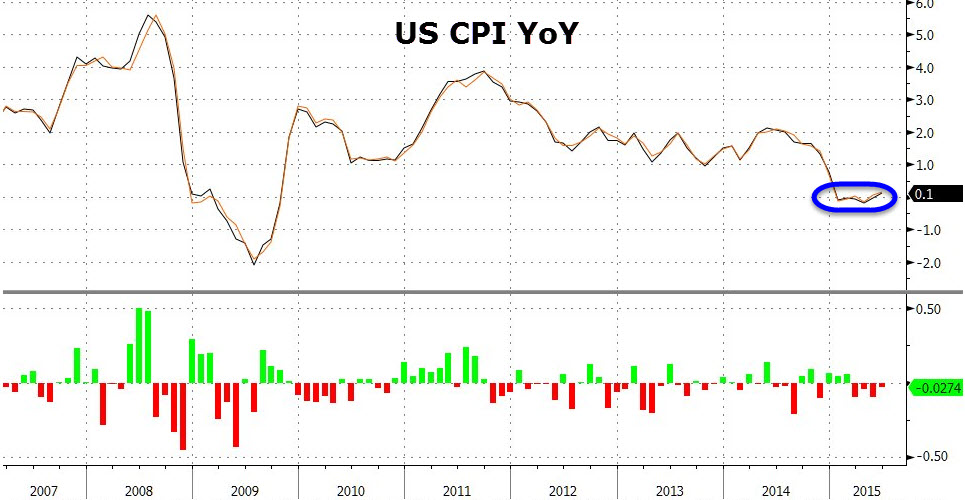
Core CPI, which excludes food and energy related costs, increased 0.2 percent month on month following a rise of 0.1% previously. On an annualized basis, core CPI has now risen 1.8 percent.The June reading continues to highlight just how tame the inflationary environment is within the US economy at present. The strong dollar is helping to keep a lid on inflation by reducing the price of imports and wholesale costs. The strong US dollar has been been spurred partly by a flight to safety due to concerns in Europe and China, and partly by the market’s anticipation of a Fed rate hike later this year. We should expect to start hearing comments regarding the damaging effects of the stronger dollar by Fed officials in the weeks and months ahead should this trend continue.
The food index posts largest increase since September 2014
The price of food increased 0.3% in June, largely to an ongoing shortage in wholesale eggs which has caused a sharp jump in retail egg prices across the nation. Egg prices jumped 18.3% in June, the largest monthly gain since August 1973. Elsewhere, the index for meats, poultry, fish, and eggs rose 1.4 percent in June, with the beef index rising 0.9 percent. Food prices are likely to remain elevated in the coming months as the aftermath of the bird flu epidemic works its way through the supply chain. Wholesale food costs have been consistently increasing in PPI surveys, and these costs are likely to make their way down to the consumer in the weeks and months ahead.
Medical Price Inflation starting to cool off
Medical related inflation cooled in June which will be a welcome deviation from the overall trend in 2015. The price for Medical Care Services fell -0.2% in June and the prices for Medical Care Commodities remained unchanged month on month. Health care costs have been one of the largest contributors to inflation over the past 12 months, with both indices rising 2.3 percent and 3.3 percent respectively.
Rent Prices continue to Climb Higher
The shelter index climbed 0.3% in June, and 3% on an annualized basis as the supply of housing continues to shrink in key regions. Rent increases are also amongst the largest contributors to overall inflation in the United States within the past 12 months.
Outlook for Rates
This month’s CPI data contains no surprises, and the relatively tame reading in the core number on the back of the strong US dollar will likely stick in the minds of Fed officials in the weeks ahead. Globally, sentiment continues to wane dramatically given the continued turmoil in Greece, and increasingly China. While Greece appears to be on the verge of some sort of political settlement, the headline risk remains. In China’s case, there is a very real danger of investor sentiment turning, which could spell disaster for emerging markets overall. Latin American and South East Asian markets look at particular risk, especially on the currency front. The fate of these regions would be sealed in no uncertain terms should the Fed raise rates, and it is for this reason that it appears increasingly unlikely that the Fed will raise by year end, despite all of their rhetoric and expressed intention to do so.
by Andrew | Jul 10, 2015 | In the news, Inflation

Rising tensions within global financial markets were the dominant concerns among Fed officials according to minutes just released from their June policy meeting, leading to yet another delay in the Fed’s widely anticipated normalization of interest rate policy. Uncertainty surrounding the future of Greece and ongoing market weakness in China triggered a cautious tone among most members, although signs of continued strength in the domestic economy, especially the labor and housing markets provided enough signs encouragement for other members to favor a rate hike in the near future.
The tug of war between these two forces will be the dominant theme for Fed watchers going forward, and signs of either beginning to dominate in the weeks ahead should offer some more concrete insight into the timing of the Fed’s next move.
In the Fed’s own words:
“Many participants emphasized that, in order to determine that the criteria for beginning policy normalization had been met, they would need additional information indicating that economic growth was strengthening, that labor market conditions were continuing to improve, and that inflation was moving back toward the Committee’s objective.”
The Fed is essentially adopting a “wait and see” approach before pulling the trigger on a rate hike which might seem premature in hindsight.
The Good – Labor Market Continues to Pick Up
On a positive note, job creation and improved employment prospects according to official figures has buoyed the Fed’s expectations for wage growth to pick up for the rest of the year. Recent consumer confidence surveys echo the Fed’s optimism, with average consumers hopeful of real wage increases in the coming months. Increased wage growth would help boost the domestic economy going forward, and the Fed will likely keep monitoring the retail sales data and employment figures closely in the weeks and months ahead for signs of a solid platform of growth emerging.
The Bad and The Ugly – Greece Weighs on Fed Outlook
Dissecting the June minutes in more detail reveals the Fed’s growing concern about the disruptive influence of overseas market turmoil arriving on domestic shores. Greece clearly weighed on policy makers minds, with particular focus on the contagion “Grexit” would cause for European financial institutions, and the domino effect this could have on US banks.
The Fed didn’t mince any words in this regard.
“[M]any participants expressed concern that a failure of Greece and its official creditors to resolve their differences could result in disruptions in financial markets in the euro area, with possible spillover effects on the United States.”
An important point to note is that the June FOMC policy meeting took place well before the most recent turmoil in Greece really flared up. It’s almost certain that the Fed would be adopting even softer language surrounding Greece given recent events. The Chinese stock market has also imploded in recent weeks, and is likely to overshadow even Greece in the near future as the biggest threat to worldwide economic stability. In recent weeks China has employed a variety of increasingly desperate measures to help slow the stock market decline, but neighboring countries in the Asia Pacific region will be looking on anxiously for signs of contagion in the near future.
Inflation continues to remain below target
On the inflation front, the minutes identified stabilizing oil prices as a potential boost to inflationary pressures within the economy in the coming months. The Fed expects increased energy costs combined with a tightening labor market to help push inflation back towards its target of 2% by the end of year – current levels are well below target.

Summing up the inflation environment and economic picture in the Fed’s own words:
“The information reviewed for the June 16-17 meeting suggested that real gross domestic product (GDP) was increasing moderately in the second quarter after edging down in the first quarter. Labor market conditions improved somewhat further in recent months. Consumer price inflation continued to run below the FOMC’s longer-run objective of 2 percent and was restrained significantly by earlier declines in energy prices and decreases in prices of non-energy imports. Survey measures of longer‑run inflation expectations remained stable, while market-based measures of inflation compensation were still low.”
In summary, it is clear there is growing sense of frustration within the Fed with regards to its inability to start normalizing rates which have been set near zero percent since the onset of the 2008 crisis. With ongoing stress in world financial markets, the Fed knows a premature hike in rates would be enough to send many nations over the edge into a full blown recession. Upcoming domestic data will be key in the coming weeks, should there be a deterioration in the domestic economic picture, then all bets for any form of rate hike this year would certainly be off.
by Andrew | Jun 5, 2015 | Inflation
One of the more interesting sets of data to catch our attention in recent months is the National Association of Credit Managers CMI Index – a broad measure of the underlying credit conditions affecting both the manufacturing and service sectors in the US economy. The CMI has proved to be a valuable leading indicator since its inception in 2002, successfully predicting both the start and the end of the credit crisis in 2007 and 2009 respectively.
Given the important role credit plays in the overall economy, following a gauge of credit conditions on a month to month basis provides an excellent insight into just how healthy the flow of credit is throughout the business sector. From this vantage point, the trend emerging from recent data is worrying on all fronts and could have serious ramifications for the economy in remaining quarters of 2015.
Full Blown Recessionary Signal in March (or is it… )
In March, the CMI data recorded the biggest deterioration of business credit conditions in over 7 years. The fall in the unfavorable factors part of the index, tumbled from 50.5 to 48.5 – the lowest level since the 2008 recession formally ended. The data turned the heads of many analysts due to the severity of the drop. In the NACM’s own words:

“There is quite obviously some serious financial stress manifesting in the data and this does not bode well for the growth of the economy going forward. These readings are as low as they have been since the recession started and to see everything start to get back on track would take a substantial reversal at this stage. The data from the CMI is not the only place where this distress is showing up, but thus far, it may be the most profound”
Thankfully, if not somewhat surprisingly, the NACM made significant revisions to the March data in its April release – with the sharp falls in February and March replaced with less apocalyptic data points. The massive declines in February and March were revised from 52.1 and 46.1 respectively to 60.5 and 60.6, quite an enormous revision, and one which the NACM were rather vague in explaining. Again, in their own words:
“In February and March the CMI seemed to show a drastic drop in the amount of credit extended by companies to those that wanted to buy their machines or commodities and inventory. There was also a big drop in the number of credit applications submitted. Many of the other categories were also in decline, but these were the most dramatic. Upon reviewing the data and assessing some of the additional numbers it seems that there was not quite the drama originally noted.”
So.. credit crunch avoided, but the data has stoked our curiosity about what exactly did occur in February and March. If credit conditions deteriorated so badly during this period, the trend should surely be mirrored in the consumer credit data – we cracked open the Fed’s latest Consumer Credit report to take a look.
Consumer Revolving Credit Slowdown
While the Fed’s consumer credit lags the NACM (the Fed only has data up until March, the NACM CMI is current through the month of April) the data nevertheless appears to confirm the initial view from the CMI – a significant deterioration in credit availability did occur in the first quarter of 2015. From the Fed’s data, revolving credit fell -3.3% in both January and February of this year before rebounding +5.9% in March, signalling a severe slowdown in credit creation in the early part of the first quarter from non government sources. This was the worst month for revolving credit (predominantly credit cards) since December 2010 and paints a worrying picture regarding the health of the US consumer going forward.

Compounding the sluggish consumer, there also seems to be credit aversion occurring throughout the big banks, with the Fed’s data showing outstanding consumer credit held at depository institutions down -2.5% from the fourth Q4 2014 to March 2015. It would appear from this data that the big banks have pulled their horns in with respect to extending credit to both businesses and consumers in the first three months of 2015 as uncertainty reigns supreme with regards to the timing of the Fed’s next rate hike.
Both data sets have certainly caught our interest and we will be monitoring the Fed’s latest credit report scheduled for release on June 7 for signs of how the current trend is progressing. In the meantime, the data clearly shows the economy is in far less robust health than those calling for a rate hike would care to imagine. The recent fall in global PMIs and factory orders in the US are further signs of a slowdown occurring – we have been calling for an extended period of delayed rate hikes for a while, but this current data seals it.
by Andrew | Apr 26, 2015 | Definitions, Inflation, inflation measure

Central banks around the world have been consistent in their policy response to the 2008 financial crisis; aggressive quantitative easing and zero interest rate policies have formed the backbone of policy responses for nearly a decade. The initial effectiveness of these policies was a huge feather in the cap of these central banks, most notably the Fed who managed to avert one of the biggest financial catastrophes of the modern era. Now into the seventh year post-lehman however, it is becoming less clear what exit strategy is in place for the numerous QE programs in place throughout the world, and what consequences these policies will have for the global economy in the long run.
Since the Fed tapered its bond purchases in October 2014, other central banks have stepped in aggressively to pick up the slack. Japan has been printing an unrivaled amount of money as part of Shinzo Abe’s stimulus package for the Japanese economy, and the ECB has been on the QE trail since January, promising to buy up to 1.1 trillion euros up until September 2016.
The ECB kickstarted its bond purchase program due to the threat of deflation taking root across the Eurozone much like the Fed’s initial fear of a deflationary spiral emerging in the aftermath of the credit crisis. With deflation now at the forefront of most investors minds given the falling oil price and subdued CPI over the past few months, it seems increasingly likely that these stimulus programs will be in place for the foreseeable future. In the long run however, what are the unintended consequences of these QE programs from the world’s central banks?
Fundamentals are becoming increasingly irrelevant: A rising tide lifts all boats
One of the most dangerous side effects of QE is the impact it has had on investment analysis. Monetary policy, above all else, has become the primary driving force behind markets globally. Fundamental analysis has become, by and large, irrelevant in the face of an ever expanding amount of liquidity chasing a finite amount of assets. Earnings reports are still dissected and talked about in depth, but increasingly these traditional forms of analysis are becoming less and less relevant.
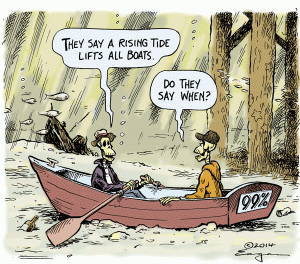
Market valuations across the globe are stretched, bond valuations are at multi century highs, and high end real estate has been bid up to unbelievable levels. The exuberant valuations are overlooked in the belief that a steady flow of liquidity will continue to boost prices going forward.
Savers have been crushed during this whole process
The effect QE has had on interest rates globally has led to a very rough road for savers during this period. Returns have been cut to almost nothing, and in more recent years, the threat of negative interest rates and deposit taxes in certain parts of the world have added to the malaise confronting savers. In the long run, this will turn out to be one of the biggest failures of QE. For new entrants into the labor market since 2007 there has been very little yield available from conventional saving accounts. As a consequence, an entire new investment paradigm is starting to take root, formed primarily on more speculative and riskier investment principles. Savings and capital formation are an essential component of any well functioning economy. Destroying the incentive for people to save is perhaps the biggest regret we will have about QE when the pigeons eventually come home to roost.
Global Missallocation of Capital
Interest rates within the United States have always acted as the bellwether for risk on a global scale. The yield on 10 year treasury bonds has always been the traditional “risk free” rate of return. With US interest rates at near zero, evaluating risk has become an increasingly difficult result. As a result, risk premiums have been contracting around the world and yield starved capital has been flowing into markets and countries which historically would have been avoided. Emerging Markets have seen an unprecedented increase in capital flows which has resulted in some spectacular misallocation of capital within both commercial real estate, residential real estate and financial markets within these countries. We are starting to see some of these investment excesses start to unwind – and these markets look ripe for sustained weakness should interest rates begin to normalize in the near future.
What happens next?
The exit strategy for many of the various QE programs remains a great uncertainty. The Fed has officially tapered its bond purchase program since October 2014 but has held rates at near zero ever since. The challenge facing policy makers going forward is how to unwind the ultra stimulative policies of the last decade without causing a full fledged market crash.
For now, the proceeds of these policies have been pretty well confined in financial assets, creating a two speed economic system where inflation and growth appear to be occurring at a different paces within the real economy and the financial world. There really is no way of knowing what will result as a consequence of pulling QE from under the feet of the financial system. If some of the excess of the financial system starts to manifest itself within the CPI, then there is no way of telling where this will end. 2015 is shaping up to be an important chapter in the whole post-lehman story.
by Andrew | Apr 6, 2015 | Definitions, Inflation

The accelerating pace of deflation across the world’s major economies is fast becoming one of the most influential forces for financial markets in 2015. We are already starting to see consensus interest rate expectations shift from a widely expected hike in June, to a delayed hike in September, and indeed, some market commentators are viewing the ongoing deflationary trend as a sign that interest rates are likely to remain unchanged for the foreseeable future. The Fed’s interest rate decision is fast becoming the fulcrum upon which entire countries, companies, and individuals find their economic well being balanced upon, highlighting a growing imbalance which exists between the monetary and policy setting classes and everyone else.
What prices are falling? I can’t see them anywhere!
Average Americans can be forgiven for failing to see any material decrease in prices which affect the most important aspects of their daily life – in truth, it has never been more expensive to sustain a middle class lifestyle in America, a lifestyle which once upon a time was the bedrock of the American dream and the envy of the entire industrialized world. Healthcare, education, food, and housing, all prominent components of a comfortable middle class lifestyle are often millstones around the necks of many working Americans at best, and completely unattainable at worst.
Education – the biggest hurdle in life?
Education has never been as expensive as it is today. Despite the explosion of the world wide web and mass communication technologies throughout the 1990s and 2000s, the information age paradoxically, at least accredited information as it exists via traditional higher education degrees, comes with an extravagant price tag well out of reach for ordinary people.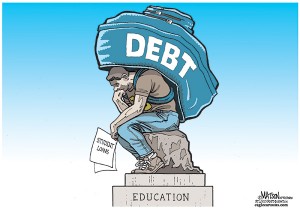 As a consequence, the youth of today are forced into carrying an enormous debt burden, a burden they will be repaying throughout their entire lives. These youth are effectively forced into these decisions at a period in their life when they have the least amount of experience and understanding of how the world at large operates.
As a consequence, the youth of today are forced into carrying an enormous debt burden, a burden they will be repaying throughout their entire lives. These youth are effectively forced into these decisions at a period in their life when they have the least amount of experience and understanding of how the world at large operates.
Shifting employment trends make education decisions even more stressful than they already are. As a consequence we have reached an unprecedented point of personal indebtedness – student loans for higher education are just one face of the prism, when all forms of personal indebtedness are viewed in aggregate, we see ordinary Americans stuck well and truly behind the eight ball with regards to social mobility.
This is a damning reflection of just how securitized the world is becoming through the financial sector and highlights one of the greatest problems we are facing as a society – the accelerating two tiered economic system which exists within the world today. Those with access to a printing press, and those who don’t.
The Economic Solar System: The universe revolves around the Fed
It is becoming increasingly clear that the policies deployed in response to the 2008 financial crisis have enriched the top 1% of Amercians at the expense of the ordinary people of the working and middle class. This has largely occurred through one of the biggest wealth transfers in history– labor and savers have been undermined during this period in order to keep the financial markets fluid. The resulting system is very much like the conventional model of our solar system.  Investment Banks, Corporations, Small Business, and average Joe all orbit the Federal Reserve as part of the wider economy. Investment Banks have a direct relationship with the Fed and occupy the first orbital. As a consequence, they are the first recipients of the money generated from the Fed’s printing press – this places the banks – the very same institutions which brought the world economy to its knees in 2008, with the most advantageous position in the world economy today. Banks are able to effectively choose who wins and loses under this new system. To date, the banks have decided to keep this newly printed capital in their own bank yard – in global fixed income, equity and derivatives markets. This inner most orbital has been revolving at a fevered pace for years now – equity markets and bond prices are at historical levels all over the world – some asset classes such as emerging markets are even showing signs of hyperinflation. Banks in our model would correlate directly to Mercury in the solar system model. Average people and Small Business are languishing somewhere out near Pluto in the freezing abyss of deep space, a mere speck of inconsequential light.
Investment Banks, Corporations, Small Business, and average Joe all orbit the Federal Reserve as part of the wider economy. Investment Banks have a direct relationship with the Fed and occupy the first orbital. As a consequence, they are the first recipients of the money generated from the Fed’s printing press – this places the banks – the very same institutions which brought the world economy to its knees in 2008, with the most advantageous position in the world economy today. Banks are able to effectively choose who wins and loses under this new system. To date, the banks have decided to keep this newly printed capital in their own bank yard – in global fixed income, equity and derivatives markets. This inner most orbital has been revolving at a fevered pace for years now – equity markets and bond prices are at historical levels all over the world – some asset classes such as emerging markets are even showing signs of hyperinflation. Banks in our model would correlate directly to Mercury in the solar system model. Average people and Small Business are languishing somewhere out near Pluto in the freezing abyss of deep space, a mere speck of inconsequential light.
Low Monetary Velocity is Stoking Deflation
Current deflation seems to be a direct consequence of this new economic system. The very low velocity of money, that is the rate at which money is dispersed throughout the entire system, is starting to cause the entire system to implode. Crude oil, commodities, wages, agricultural goods are all exhibiting signs of severe price deflation. As long as the economic imbalances remain within the world, more namely the severe imbalance in power and influence which the financial sector exerts over the global economy – the more likely it will be that official statistics become even more meaningless in describing the economic realities of the modern world.















